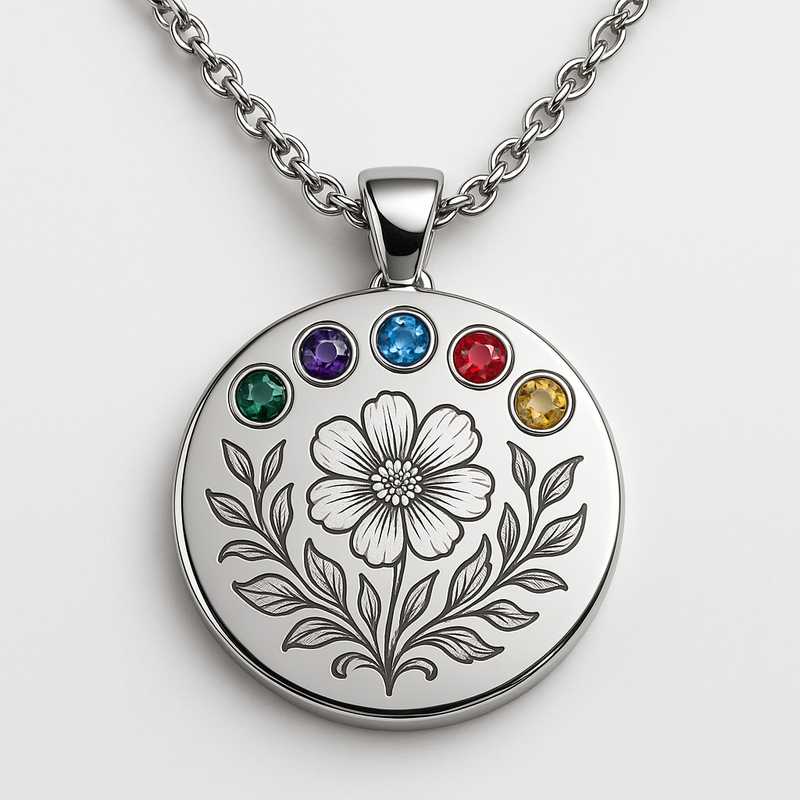Engineered Beauty: Advanced Materials in Custom Birthstone Jewelry

Explore 304 vs 316L stainless steel, precision tech, and green methods in OEM/ODM charm production
In the evolving landscape of custom jewelry manufacturing, aesthetics and engineering are no longer separate concepts—they converge. For OEM/ODM buyers seeking to develop birth month flower and birthstone charm necklaces, material performance and sustainable production now play a crucial role alongside design and trend considerations. This special page explores how advanced stainless steel materials, precision technologies, and green manufacturing methods redefine quality and longevity in personalized jewelry.
From corrosion-resistant alloys to eco-friendly processes, and laser-engraved charm detailing to hydraulic forming, today’s B2B clients demand both performance and beauty. Join us as we delve into the specific differences between 304 and 316L stainless steel, the cutting-edge technologies behind charm production, and how eco-innovation is shaping the next generation of custom jewelry.
Material Showdown: 304 vs 316L Stainless Steel in Jewelry Manufacturing
Stainless steel is favored in jewelry manufacturing for its durability, affordability, and resistance to tarnish. However, not all stainless steels are created equal. The choice between 304 and 316L can significantly affect the final product’s performance in different environments.
304 Stainless Steel: The Workhorse
304 stainless steel is one of the most commonly used alloys. It contains 18% chromium and 8% nickel, providing good corrosion resistance under typical wear conditions. It’s ideal for fashion jewelry or items not exposed to harsh chemicals or saltwater.
Advantages:
- Cost-effective for large production runs
- Good weldability and formability
- Non-magnetic and hypoallergenic properties
316L Stainless Steel: The Premium Choice
Often referred to as “surgical steel,” 316L includes an additional element—molybdenum—which significantly boosts its resistance to pitting and corrosion in chloride-rich environments such as sweat, seawater, and industrial atmospheres.
Advantages:
- Superior corrosion resistance
- Ideal for long-lasting, high-end jewelry
- Maintains luster and integrity in marine and humid conditions
Application Insight: For birthstone charm necklaces intended for global markets or luxury consumers, 316L stainless steel offers not only functional superiority but also aligns with premium brand positioning. In contrast, 304 is a reliable option for high-volume, fast-fashion jewelry where environmental exposure is minimal.
Precision Processes: From Laser Detailing to Hydraulic Forming
Jewelry manufacturing is no longer a craft limited by hand tools. Precision machinery now enables unmatched detail, consistency, and innovation. For OEM/ODM clients, understanding these processes helps in product differentiation and scalability.
Laser Cutting and Engraving
Laser cutting enables precise shape formation of birth month flower charms, allowing delicate petals and geometric patterns with high accuracy. Engraving birthstones’ names, dates, or custom messages can be achieved with micron-level depth without damaging the material’s integrity.
Key Benefits:
- Clean edges and fine detail
- Batch customization without tool changes
- Supports on-demand personalization
Hydraulic Forming and Press Techniques
Hydraulic presses are instrumental in creating three-dimensional charm elements. This method forms metal into molds under controlled pressure, ideal for creating raised flower petal textures or domed gemstone bezels.
Use Case: A recent ODM collaboration used hydraulic forming to develop a multilayered June birth flower charm (rose) that featured overlapping petals paired with a synthetic alexandrite center. The result was a sculptural piece with tactile elegance.
Corrosion Patterning
Electrochemical corrosion techniques are used to etch micro patterns onto the surface of stainless steel, adding anti-slip textures or matte-finish contrasts that enhance both grip and aesthetics. This method provides an added layer of uniqueness to custom jewelry pieces without additional coatings.
Green Manufacturing: Eco-Efficient Jewelry Production
With environmental regulations tightening and consumer demand for responsible sourcing growing, green production is not a luxury—it’s a necessity. B2B buyers now actively seek OEM partners who embed sustainability into their operations.
Waste Metal Recycling
In charm manufacturing, metal scraps from laser cutting and hydraulic stamping are collected and reprocessed in closed-loop systems. This minimizes landfill waste and recycles up to 90% of production material.
Impact Example: One of our OEM partners in Southeast Asia reports that recycling waste steel from a single charm line saved 18 tons of raw material annually, lowering costs and meeting environmental KPIs for European clients.
Green Electroplating
Traditional electroplating uses heavy metals and cyanide solutions. Green electroplating substitutes these with trivalent chromium and water-based systems, reducing toxin discharge and worker exposure risks.
- Zero-wastewater closed-loop rinsing systems
- Chrome-free brightening finishes
- ISO14001 and REACH-compliant surface treatments
Energy Efficiency and Digital Workflow
Automation and smart monitoring in production lines help optimize energy consumption. Computer-aided design (CAD) and simulation tools reduce the number of physical prototypes needed, cutting down resource usage by 40-60%.
Digital Efficiency Case: For a North American brand developing a botanical birthstone series, digital prototyping reduced sampling rounds from five to two, saving an estimated 800 hours of machine time and over 100 kg of alloy materials.
Material Meets Emotion: Aligning Engineering with Aesthetic Vision
Consumers are drawn to jewelry that resonates emotionally, yet OEM clients must also ensure technical feasibility and durability. Marrying engineered materials with design philosophy results in charms that not only look exquisite but also wear beautifully over time.
Design Synergy: Combining 316L’s marine-grade endurance with laser engraving allows you to offer beach-safe jewelry with personalized inscriptions. Pair this with eco-plated birthstones and flower motifs, and your collection becomes a story of elegance, strength, and conscience.
Market Differentiation Tip: Promote collections with narratives—”Engineered for Generations,” “Beauty that Withstands the Elements,” or “Eco-Elegant Legacy”—to align material science with brand storytelling.
Conclusion: Partnering for Performance and Prestige
Whether you’re building a new charm collection or refining an existing line, the materials and technologies behind each piece matter more than ever. From choosing the optimal stainless steel alloy to integrating green practices and precision fabrication, your decisions define your brand’s performance and perception.
Ready to elevate your next jewelry project? Collaborate with our team to develop custom birthstone and birth flower necklaces that unite cutting-edge manufacturing, ethical sourcing, and timeless design. Discover how engineered beauty can become your competitive edge in the global OEM/ODM market.
